IRAS16293 Band9 - Calibration for CASA 3.3: Difference between revisions
No edit summary |
No edit summary |
||
| (33 intermediate revisions by 2 users not shown) | |||
| Line 36: | Line 36: | ||
Be sure that you are using the right version indicated for this guide. | Be sure that you are using the right version indicated for this guide. | ||
==Install Analysis Utilities== | |||
Analysis Utilities (or analysisUtils for short) is a small set of Python scripts that provide a number of analysis and plotting utilities for ALMA data reduction. This guide uses a few of these utilities. They are very easy to install (just download and untar). See | |||
http://casaguides.nrao.edu/index.php?title=Analysis_Utilities | |||
for a full description and download instructions. If you do not wish to do this, see a CASA 3.3 version of one of the other ALMA guides for alternative (but slow) plotting options. Analysis Utilities are updated frequently so if its been a while since you installed it, its probably worth doing it again. If you are at an ALMA site or ARC, the analysis utilities are probably already installed and up to date. | |||
==Initial Inspection== | ==Initial Inspection== | ||
The first step we will do through all the calibration process is to define an array with the uid's that | The first step we will do through all the calibration process is to define an array with the uid's that correspond to the datasets names. This will allow to make the calibration of the four datasets one after another, using a for-loop inside python. We will then calibrate the data individually and concatenate them at the end, before proceeding with the imaging part. | ||
Note that if you exit CASA and want to continue with the calibration using these arrays, you will have to re-issue the command again to make it available for the current CASA execution. | Note that if you exit CASA and want to continue with the calibration using these arrays, you will have to re-issue the command again to make it available for the current CASA execution. | ||
To start, and give an example of this process, we will create txt format files for the output of the listobs task, which will give us useful information about the observations. | To start, and give an example of this process, we will create txt format files for the output of the listobs task, which will give us useful information about the observations. | ||
<source lang="python"> | <source lang="python"> | ||
| Line 102: | Line 109: | ||
23 3840 TOPO 688437.256 488.28125 1875000 XX YY | 23 3840 TOPO 688437.256 488.28125 1875000 XX YY | ||
24 1 TOPO 687499.756 1875000 1875000 XX YY | 24 1 TOPO 687499.756 1875000 1875000 XX YY | ||
Antennas: 15: | Antennas: 15: | ||
ID Name Station Diam. Long. Lat. | ID Name Station Diam. Long. Lat. | ||
| Line 299: | Line 129: | ||
</pre> | </pre> | ||
In the previous output you can see the ID that is assigned to each source, starting with the number 0. 1924-292 and 3c279 are the calibrators for bandpass, Juno for amplitud (flux), 1625-254 is our phase calibrator and nrao530 ph serves as a check (phase calibrator) source. The remaining 7 fields of IRAS16293-2422-a are the seven pointings for our mosaic of the target source. | |||
Spectral windows are also marked with numbers from 0 to 24, with number 0 containing WVR information. Spws 17, 19, 21, and 23 contain the sience data (FDM mode). The CO (6-5) line emission is contained in spw 19. Spw 18, 20, 22, and 24 contain channel averages of the data from spectral windows 17, 19, 21, 23, respectively. These spws will not be used for the offline data reduction. All the remaining spw that appear in the section of "Sources", and that do not appear in the "Spectral Windows" section are related to WVR measurements for each antenna, so you will not need them for the calibration neither. Spws 9, 11, 13, and 15 are associated with tsys measurements, and we will apply these information to the science spws later. | |||
Finally before we go further we explicitly save the current flag state of the data. If you ever decide to start completely over, you should substitute 'restore' for 'save' in the command below to restore the flag state to its original value. | |||
<source lang="python"> | |||
# Use flagmanager to save current flag state. | |||
for data in rawdata: | |||
flagmanager(vis=data,mode='save',versionname='Original') | |||
</source> | |||
==Visualization and application of Tsys and WVR tables== | ==Visualization and application of Tsys and WVR tables== | ||
Next we need to check the plotting for tsys and wvr tables to make sure whether they have issues that might affect their application to the data. Whenever we see an odd behavior in the tables we need to flag the corresponding sience data to prevent wrong results in the calibration steps. The next command, that comes from the Analysis Utils package will plot the tsys in the next way: it will produce many plots, each one of them will show an antenna, with the four spw that tsys | Next we need to check the plotting for tsys and wvr tables to make sure whether they have issues that might affect their application to the data. Whenever we see an odd behavior in the tables we need to flag the corresponding sience data to prevent wrong results in the calibration steps. The next command, that comes from the Analysis Utils package will plot the tsys in the next way: it will produce many plots, each one of them will show an antenna, with the four spw that tsys tables cover, for all the targets, and with different colors for different times, so you can trace the behavior for tsys with time, among others. | ||
Note that in spw 19 | Note that in spw 19, the overlap with the tsys spw (11) is not set correctly. This is due to an error in the frequencies for the tsys when the observations were done. You do not have to worry about this, since any issue coming from that error has already been fixed. Note, however that the portions of the spectra that do not have tsys information cannot be used. This does not represent a problem, since that part corresponds to the edge of the baseband. Also note that the CO (6-5) line is not affected by this. | ||
In Figure 1 you will see the corresponding plot for one of the datasets (X90c) showing antenna 0 (DA41). | In Figure 1 you will see the corresponding plot for one of the datasets (X90c) showing antenna 0 (DA41). | ||
[[File:uid___A002_X3d55cb_X90c.mstsys.DA41.spw0.png|200px|thumb|right|'''Fig. 1.''' Example for the output of the | [[File:uid___A002_X3d55cb_X90c.mstsys.DA41.spw0.png|200px|thumb|right|'''Fig. 1.''' Example for the output of the command that plots the tsys spws. Find a description in the text.]] | ||
| Line 324: | Line 163: | ||
</source> | </source> | ||
Go through all the plots and make sure you notice all the next issues, since we will need to flag the corresponding science data. | |||
<pre style="background-color: #E0FFFF;"> | <pre style="background-color: #E0FFFF;"> | ||
| Line 347: | Line 186: | ||
Now, for the plotting of the wvr tables, we will employ again the analysis utils. This | Now, for the plotting of the wvr tables, we will employ again the analysis utils. This command will create a directory with all the plots inside, each one of them corresponding to different datasets, baselines and targets, using different colors. In Figure 2 you can see an example of the output for spectral window 1. Note that the command below only creates the plots for that spw, since the others are the same except for a scale factor that is the ratio of frequencies. | ||
Note that in all datasets, DV15 has bad wvr behavior. | Note that in all datasets, DV15 has bad wvr behavior. | ||
[[File:uid___A002_X3d55cb_X90c.ms.wvr.smooth.2.png|200px|thumb|right|'''Fig. 2.''' Phase corrections as funcion of time for the dataset X90c, where | [[File:uid___A002_X3d55cb_X90c.ms.wvr.smooth.2.png|200px|thumb|right|'''Fig. 2.''' Phase corrections as funcion of time for the dataset X90c, where is shown an example of the odd behavior of DV15-related baselines.]] | ||
<source lang="python"> | <source lang="python"> | ||
| Line 361: | Line 200: | ||
</source> | </source> | ||
Before you continue it is important you save the flags status, so you can recover this state if you need | Before you continue it is important you save the flags status, so you can recover this state if you need to re-do the calibration. | ||
<source lang="python"> | <source lang="python"> | ||
# Saving the flags state as "Original". | |||
rawdata=['uid___A002_X3d4118_X39b.ms','uid___A002_X3d55cb_X575.ms', | rawdata=['uid___A002_X3d4118_X39b.ms','uid___A002_X3d55cb_X575.ms', | ||
'uid___A002_X3d55cb_Xb50.ms','uid___A002_X3d55cb_X90c.ms'] | 'uid___A002_X3d55cb_Xb50.ms','uid___A002_X3d55cb_X90c.ms'] | ||
| Line 371: | Line 211: | ||
</source> | </source> | ||
Now, based on the behavior of the tsys and wvr tables, we will flag the corresponding data | Now, based on the behavior of the tsys and wvr tables, we will flag the corresponding data, using the next commands. You can employ similar executions to flag other data you might want to remove. | ||
<source lang="python"> | <source lang="python"> | ||
| Line 386: | Line 226: | ||
</source> | </source> | ||
== Applying tsys and wvr tables and splitting the data == | == Applying antpos, tsys, and wvr tables and splitting the data == | ||
As you could see from the initial application of listobs, 1924-292 is the bandpass calibrator for three of the datasets, and 3c279 is for one of them. For this reason, the application of the tables is split in two parts. Ignore the warnings from the first | As you could see from the initial application of listobs, 1924-292 is the bandpass calibrator for three of the datasets, and 3c279 is for one of them. For this reason, the application of the tables is split in two parts. Ignore the warnings from the first execution of applycal, since it does not harm the data. | ||
<source lang="python"> | <source lang="python"> | ||
| Line 447: | Line 287: | ||
== Data inspection == | == Data inspection == | ||
We now need to check any bad behavior in the data through several plots. Once problems are identified, | We now need to check any bad behavior in the data through several plots. Once problems are identified, data can be flagged. But before that, we need to run again {{listobs}} to check that the split worked as expected. We will define our new array of split datasets, along with a list of intents that will be useful in the next steps. | ||
| Line 471: | Line 311: | ||
listobs(vis=vis,listfile=vis+'.listobs',verbose=True) | listobs(vis=vis,listfile=vis+'.listobs',verbose=True) | ||
</source> | </source> | ||
You can explore any of the output files by doing cat file.listobs or using any other text | You can explore any of the output files by doing cat file.listobs or using any other text reader from a terminal not running CASA. Next you can see the output for X90c, and you will see the change in the spw naming, among others. | ||
<pre style="background-color: #fffacd;"> | <pre style="background-color: #fffacd;"> | ||
| Line 549: | Line 389: | ||
In Figure 4 you can see the output of the following plotms command. By clicking the "Next" arrow in plotms you can access the remaining spws, since the command was executed with the option iteraxis='spw'. | In Figure 4 you can see the output of the following plotms command. By clicking the "Next" arrow in plotms you can access the remaining spws, since the command was executed with the option iteraxis='spw'. | ||
[[File:X39b.antwvrtsys.ms_time_amp_spw0.png|200px|thumb|right|'''Fig. 4.''' {{plotms}} result for time | [[File:X39b.antwvrtsys.ms_time_amp_spw0.png|200px|thumb|right|'''Fig. 4.''' {{plotms}} result for amplitude vs time for all the sources, which are displayed with different colors. The plot shows spw 0.]] | ||
<source lang="python"> | <source lang="python"> | ||
| Line 605: | Line 445: | ||
</source> | </source> | ||
Here is the flag that we will do. If you note some other data that needs to be flagged, proceed with that. | |||
<source lang="python"> | <source lang="python"> | ||
| Line 613: | Line 453: | ||
</source> | </source> | ||
Now, during the procedure of calibration | Now, during the procedure of calibration some problems in the data will show up. Those data needed to be flagged and do the calibration again. In order to save you time with this, we note here those problems, so you can flag the data now. | ||
<source lang="python"> | <source lang="python"> | ||
| Line 631: | Line 471: | ||
== Calibration == | == Calibration == | ||
Now we can start with the calibration itself. First, we will perform the bandpass calibration using 1924-292 and 3c279. As before, we define our list of data and match the sources with intents. Also, we will set our reference antenna (one close to the center of the array and without problems, like delays). As you can see, two different intervals for channels are used, which make sense in a bit. | |||
<source lang="python"> | |||
data=['uid___A002_X3d4118_X39b.antwvrtsys.ms', | |||
'uid___A002_X3d55cb_X575.antwvrtsys.ms', | |||
'uid___A002_X3d55cb_X90c.antwvrtsys.ms', | |||
'uid___A002_X3d55cb_Xb50.antwvrtsys.ms'] | |||
# Match up intents with source names | |||
pcal='1625-254' | |||
fluxcal='Juno' | |||
science='IRAS16293*' | |||
check='nrao530*' | |||
bpcal=['1924-292','3c279','1924-292','1924-292'] | |||
calfields=['1924-292,Juno,1625-254,nrao530*', | |||
'3c279,Juno,1625-254,nrao530*', | |||
'1924-292,Juno,1625-254,nrao530*', | |||
'1924-292,Juno,1625-254,nrao530*'] | |||
# Setup calibration parameters | |||
prebpchan='0~3:1200~1500' | |||
calchan='0~3:20~3820' | |||
refant='DV14' | |||
gaps=5 | |||
os.system('rm -rf *cal') | |||
</source> | |||
Note that if at some point during the calibration process you need to start over, then you will need to clear all the columns for solutions in the data, as shown next. | |||
<source lang="python"> | |||
# The clearcal below is essential if you are starting over | |||
for vis in range(len(data)): | |||
clearcal(vis=data[vis]) | |||
setjy(vis=data[vis],field=fluxcal,standard='Butler-JPL-Horizons 2010', | |||
scalebychan=True) | |||
</source> | |||
Now we proceed with the bandpass, which will be done in two steps. In the first one, we will use the block of channels in the center of the spws, 1200~1500, to calculate gains in phase, using a solution interval of 30 seconds. This will give us the variation of the phase through all the observation. We will use this table later to execute the {{bandpass}} itself. Note that we are using a minimum of signal to noise ratio of 2 to accept the solutions. This is low but needed since the calibrators are not very strong in band 9. | |||
<source lang="python"> | |||
# Calculating phase variation with time | |||
for vis in range(len(data)): | |||
gaincal(vis=data[vis],caltable=data[vis]+'.bpphase.gcal', | |||
field=bpcal[vis],spw=prebpchan,refant=refant, | |||
calmode='p',solint='30s',minsnr=2.0,minblperant=4) | |||
</source> | |||
Next, we set our bandpass command to use our previously generated gain tables. Since we do not have a high signal to noise ratio per channel, we use a polynomial option to calculate the solutions for the bandpass. In the {{bandpass}} task, the options degamp and degphase will set the maximum degree of the polynomial that the task can use to calculate solutions. In the work log you can note what is the actual degree that the task is using. Note that the combination of solint='inf' and combine='scan' will result in a solution per scan for the calibrator. | |||
<source lang="python"> | |||
# Bandpass calibration using previous tables as input | |||
for vis in range(len(data)): | |||
bandpass(vis=data[vis],caltable=data[vis]+'.bandpass.bcal', | |||
field=bpcal[vis],spw='',combine='scan',refant=refant, | |||
solint='inf',solnorm=T,minblperant=4,fillgaps=gaps, | |||
gaintable=[data[vis]+'.bpphase.gcal']) | |||
for vis in range(len(data)): | |||
bandpass(vis=data[vis],caltable=data[vis]+'.bandpass_bpoly.bcal', | |||
field=bpcal[vis],spw='',combine='scan',refant=refant, | |||
solint='inf',solnorm=T,minblperant=4,fillgaps=gaps, | |||
bandtype='BPOLY',degamp=7,degphase=7, | |||
gaintable=[data[vis]+'.bpphase.gcal']) | |||
</source> | |||
To plot all our tables we will use both our AnalysisUtils and {{plotcal}}. The aU.plotbandpass command will create plot files for each combination of dataset and antenna, for both amplitude and phase. Inspect all these plots to make sure that the bandpass solutions look good. | |||
In Figure 5 we show an output sample for this command. | |||
[[File:uid___A002_X3d55cb_X90c.antwvrtsys.ms.bandpass_bpoly.DA41.spw0.t1.png|200px|thumb|right|'''Fig. 5.''' Bandpass solutions for the dataset X90c showing antenna DA41. Both amplitude and phases solutions are plotted.]] | |||
<source lang="python"> | |||
# Set some plotting things | |||
SPW=['0','1','2','3'] | |||
numants=16 # max for any of the input datasets | |||
os.system('rm -rf cal_plots') | |||
os.system('mkdir cal_plots') | |||
os.system('rm -rf cal_plots/*bandpass_bpoly.bcal.*png') | |||
for vis in range(len(data)): | |||
aU.plotbandpass(caltable=data[vis]+'.bandpass.bcal', | |||
caltable2=data[vis]+'.bandpass_bpoly.bcal', | |||
field=bpcal[vis],xaxis='freq',yaxis='both', | |||
figfile='cal_plots/'+data[vis]+'.bandpass_bpoly.png', | |||
interactive=False,subplot=42) | |||
</source> | |||
The next step in the calibration is to calculate amplitude and phase gains vs time for our calibrators. The ideal case here is to have a solution per integration of the data, but in this case we will need to use a solution interval of 30 seconds to avoid having many failed solutions, especially in the week phase calibrator. First, we will calculate gains for phase and later using that information, we will solve for amplitude and phase. In all the next three executions we are using the bandpass calibration table, as it provides the gains for phase and amplitude vs frequency. | |||
<source lang="python"> | |||
#Using 30s (5 integrations) per solution to avoid many failed solution of the week calibrator. | |||
for vis in range(len(data)): | |||
gaincal(vis=data[vis],caltable=data[vis]+'.intphase.gcal', | |||
field=calfields[vis],spw=calchan,refant=refant, | |||
calmode='p',solint='30s',minsnr=2.0,minblperant=4, | |||
gaintable=[data[vis]+'.bandpass_bpoly.bcal']) | |||
</source> | |||
To plot our *.intphase.gcal tables we use the next command, which will create files containing the phase gains vs time for all the atennas and for all the datasets. | |||
In Figure 6 we show an example of such plots. Again, you will need to check all plots to make sure the solutions are good. | |||
[[File:uid___A002_X3d55cb_X90c.antwvrtsys.ms.intphase.gcal.spw0.ant0_4.png|200px|thumb|right|'''Fig. 6.''' Phase gain solutions vs time for our calibrators in the case of X90c showing antennas 0-4.]] | |||
<source lang="python"> | |||
# Plotting phase gains vs time | |||
os.system('rm -rf cal_plots/*intphase*png') | |||
for vis in data: | |||
for spw in SPW: | |||
for antenna in range(0,numants,5): | |||
plotcal(caltable=vis+'.intphase.gcal', | |||
xaxis='time',yaxis='phase',antenna='%d~%d'%(antenna,antenna+4), | |||
iteration='antenna',subplot=511,poln='',spw=spw, | |||
showgui=F, | |||
figfile='cal_plots/'+vis+'.intphase.gcal.spw%s.ant%d_%d.png'%(spw,antenna,antenna+4), | |||
fontsize=8.0,plotrange=[0,0,-180,180]) | |||
</source> | |||
Next we will use gaincal to solve for gain phases for all the calibrators, but this time we will get one single solution per scan. | |||
<source lang="python"> | |||
# Gaincal execution as before, but to get a single solution per scan | |||
for vis in range(len(data)): | |||
gaincal(vis=data[vis],caltable=data[vis]+'.scanphase.gcal', | |||
field=calfields[vis],spw=calchan,refant=refant, | |||
calmode='p',solint='inf',minsnr=2.0,minblperant=4, | |||
gaintable=[data[vis]+'.bandpass_bpoly.bcal']) | |||
</source> | |||
The next command will produce many plots, and like the previous one, you will get one for each dataset and for each antenna. See example in Figure 7. | |||
[[File:uid___A002_X3d55cb_X90c.antwvrtsys.ms.scanphase.gcal.spw0.ant0_4.png|200px|thumb|right|'''Fig. 7.''' Phase gain solutions vs time for all the calibrators in the case of X90c showing antennas 0-4. Note that there is only one solution per scan for each source.]] | |||
<source lang="python"> | |||
# Phase vs time plotting for our calibrators | |||
os.system('rm -rf cal_plots/*scanphase*png') | |||
for vis in data: | |||
for spw in SPW: | |||
for antenna in range(0,numants,5): | |||
plotcal(caltable=vis+'.scanphase.gcal', | |||
xaxis='time',yaxis='phase',antenna='%d~%d'%(antenna,antenna+4), | |||
iteration='antenna',subplot=511,poln='',spw=spw, | |||
showgui=F, | |||
figfile='cal_plots/'+vis+'.scanphase.gcal.spw%s.ant%d_%d.png'%(spw,antenna,antenna+4), | |||
fontsize=8.0,plotrange=[0,0,-180,180]) | |||
</source> | |||
Finally, in the next {{gaincal}} we will solve for amplitude and phase. We ill use the gain phase calibration table produced before. We will get one solution per scan for all our calibrators. | |||
<source lang="python"> | |||
# Gaincal solving for amplitude and phase vs time. | |||
for vis in range(len(data)): | |||
gaincal(vis=data[vis],caltable=data[vis]+'.amp.gcal', | |||
field=calfields[vis],spw=calchan,refant=refant, | |||
calmode='ap',solint='inf',minsnr=2.0,minblperant=4, | |||
gaintable=[data[vis]+'.bandpass_bpoly.bcal',data[vis]+'.intphase.gcal']) | |||
</source> | |||
We now can check the resulting plots with the next plotcal executions. In Figure 8 we show an example of these plots. | |||
[[File:uid___A002_X3d55cb_X90c.antwvrtsys.ms.amp.gcal.spw0.ant0_4.png|200px|thumb|right|'''Fig. 8.''' Gain amplitudes for all the calibrators, as function of time. A plot for X90c is shown with 4 antennas in it. As in the previous plot, there is only one solution per scan for each source.]] | |||
<source lang="python"> | |||
# Plotting gain amplitudes as function of time. | |||
os.system('rm -rf cal_plots/*amp*png') | |||
for vis in data: | |||
for spw in SPW: | |||
for antenna in range(0,numants,5): | |||
plotcal(caltable=vis+'.amp.gcal', | |||
xaxis='time',yaxis='amp',antenna='%d~%d'%(antenna,antenna+4), | |||
iteration='antenna',subplot=511,poln='',spw=spw, | |||
figfile='cal_plots/'+vis+'.amp.gcal.spw%s.ant%d_%d.png'%(spw,antenna,antenna+4), | |||
fontsize=8.0) | |||
</source> | |||
We can plot the same tables but in a different way that will allow us to look for higher abnormal gains in the solutions. With the next command we will get only four plots for each spw. Each of those plots shows all the gains for all the antennas for all the sources (See Figure 9 for an example). Below in the box, there are some comments to focus you on some data, so you can double check. Before continuing, make sure you check all the calibration tables. | |||
[[File:uid___A002_X3d55cb_X90c.antwvrtsys.ms.amp.png|200px|thumb|right|'''Fig. 9.''' Gain amplitudes for all the calibrators, as function of time (X90c) for the spw 2. The plot shows all the antennas in each plot. Check for higher gains that deviate from the average.]] | |||
<source lang="python"> | |||
# Look for low or high gains compared to other data | |||
os.system('rm -rf *amp.png') | |||
for vis in data: | |||
plotcal(caltable=vis+'.amp.gcal', | |||
xaxis='time',yaxis='amp',antenna='',field='', | |||
iteration='spw',subplot=221,poln='',spw='', | |||
showgui=False,figfile=vis+'.amp.png') | |||
# X90c good | |||
# X575 one antenna spw=0 | |||
# Xb50 end times bad all spws (low el), spw=0 more; low DV02 on Juno | |||
# X39b low DV02 on Juno | |||
</source> | |||
Now that the gain calibration is done, we need to set the flux for our calibrators. For this we will use | |||
Juno, our primary flux calibrator. We will do this by using {{fluxscale}}. | |||
We then will transfer the flux information from our phase calibrator to our science target. | |||
For these datasets, we note the following for this step: | |||
The derived flux densities for X39b, X90c, and Xb50 are quite | |||
reasonable. The results for X575 are a little high, probably because | |||
Juno was at low elevation for these observations. | |||
<source lang="python"> | |||
# Setting fluxes for the calibrators | |||
for vis in range(len(data)): | |||
fluxscale(vis=data[vis],caltable=data[vis]+'.amp.gcal', | |||
fluxtable=data[vis]+'.flux.cal',reference=fluxcal) | |||
</source> | |||
Analyze all the numbers coming out in the log window and write them now, as they can serve you as a reference later on. | |||
When derived fluxes are too high and nothing else appears wrong with | |||
the data, the cause especially at Band 9 is likely decorrelation. So | |||
we will favor the average of the lower values to explicitly set the | |||
flux densities based on the {{fluxscale}} results. We set the two | |||
bandpass calibrators for convenience of having fully calibrated | |||
dataset. The only ones that really matter are 1625 as the gain | |||
calibrator and the check source nrao530. | |||
Based on this, we proceed as following to make the changes that are needed: | |||
<source lang="python"> | |||
# Fixing the fluxes | |||
flux1924=[1.7,0,0,0] | |||
flux1625=[0.31,0,0,0] | |||
fluxnrao530=[0.47,0,0,0] | |||
flux3c279=[7.4,0,0,0] | |||
datawith1924=['uid___A002_X3d4118_X39b.antwvrtsys.ms', | |||
'uid___A002_X3d55cb_X90c.antwvrtsys.ms', | |||
'uid___A002_X3d55cb_Xb50.antwvrtsys.ms'] | |||
for vis in datawith1924: | |||
setjy(vis=vis,field='1924-292',fluxdensity=flux1924) | |||
setjy(vis=vis,field='1625-254',fluxdensity=flux1625) | |||
setjy(vis=vis,field='nrao530*',fluxdensity=fluxnrao530) | |||
setjy(vis='uid___A002_X3d55cb_X575.antwvrtsys.ms',field='3c279', | |||
fluxdensity=flux3c279) | |||
</source> | |||
We now need to re-run the amplitude calibration step. | |||
<source lang="python"> | |||
#This new amplitude calibration will be used in the applycal. | |||
data=['uid___A002_X3d4118_X39b.antwvrtsys.ms', | |||
'uid___A002_X3d55cb_X575.antwvrtsys.ms', | |||
'uid___A002_X3d55cb_X90c.antwvrtsys.ms', | |||
'uid___A002_X3d55cb_Xb50.antwvrtsys.ms'] | |||
# Match up intents with source names | |||
pcal='1625-254' | |||
fluxcal='Juno' | |||
science='IRAS16293*' | |||
check='nrao530*' | |||
bpcal=['1924-292','3c279','1924-292','1924-292'] | |||
calfields=['1924-292,Juno,1625-254,nrao530*', | |||
'3c279,Juno,1625-254,nrao530*', | |||
'1924-292,Juno,1625-254,nrao530*', | |||
'1924-292,Juno,1625-254,nrao530*'] | |||
for vis in range(len(data)): | |||
gaincal(vis=data[vis],caltable=data[vis]+'.amp.final.gcal', | |||
field=calfields[vis],spw=calchan,refant=refant, | |||
calmode='ap',solint='inf',minsnr=2.0,minblperant=4, | |||
gaintable=[data[vis]+'.bandpass_bpoly.bcal',data[vis]+'.intphase.gcal']) | |||
</source> | |||
== Application of calibration tables == | |||
Now that we have all the calibration tables and that we are happy with the results, both in gains and fluxes, we need to apply all the tables to the data. | |||
<source lang="python"> | |||
data=['uid___A002_X3d4118_X39b.antwvrtsys.ms', | |||
'uid___A002_X3d55cb_X575.antwvrtsys.ms', | |||
'uid___A002_X3d55cb_X90c.antwvrtsys.ms', | |||
'uid___A002_X3d55cb_Xb50.antwvrtsys.ms'] | |||
# Match up intents with source names | |||
pcal='1625-254' | |||
fluxcal='Juno' | |||
science='IRAS16293*' | |||
check='nrao530*' | |||
bpcal=['1924-292','3c279','1924-292','1924-292'] | |||
for vis in range(len(data)): | |||
flagmanager(vis=data[vis],mode='save',versionname='beforeapplycal') | |||
for vis in range(len(data)): | |||
applycal(vis=data[vis],field=bpcal[vis], | |||
gaintable=[data[vis]+'.bandpass_bpoly.bcal',data[vis]+'.intphase.gcal', | |||
data[vis]+'.amp.final.gcal'], | |||
interp=['nearest','nearest','nearest'], | |||
gainfield=[bpcal[vis],bpcal[vis],bpcal[vis]],flagbackup=F,calwt=F) | |||
for vis in range(len(data)): | |||
applycal(vis=data[vis],field=pcal, | |||
gaintable=[data[vis]+'.bandpass_bpoly.bcal',data[vis]+'.intphase.gcal', | |||
data[vis]+'.amp.final.gcal'], | |||
interp=['nearest','nearest','nearest'], | |||
gainfield=[bpcal[vis],pcal,pcal],flagbackup=F,calwt=F) | |||
for vis in range(len(data)): | |||
applycal(vis=data[vis],field=fluxcal, | |||
gaintable=[data[vis]+'.bandpass_bpoly.bcal',data[vis]+'.intphase.gcal', | |||
data[vis]+'.amp.final.gcal'], | |||
interp=['nearest','nearest','nearest'], | |||
gainfield=[bpcal[vis],fluxcal,fluxcal],flagbackup=F,calwt=F) | |||
for vis in range(len(data)): | |||
applycal(vis=data[vis],field=science, | |||
interp=['nearest','linear','linear'], | |||
gaintable=[data[vis]+'.bandpass_bpoly.bcal',data[vis]+'.scanphase.gcal', | |||
data[vis]+'.amp.final.gcal'], | |||
gainfield=[bpcal[vis],pcal,pcal],flagbackup=F,calwt=F) | |||
for vis in range(len(data)): | |||
applycal(vis=data[vis],field=check, | |||
interp=['nearest','linear','linear'], | |||
gaintable=[data[vis]+'.bandpass_bpoly.bcal',data[vis]+'.scanphase.gcal', | |||
data[vis]+'.amp.final.gcal'], | |||
gainfield=[bpcal[vis],pcal,pcal],flagbackup=F,calwt=F) | |||
</source> | |||
== Plot corrected data == | |||
The next commands will help you visualize the result of the application of the calibration tables to the data. You can check if the amplitudes and phases vs time and frequency look reasonable for all the sources, in particular for the science target fields. | |||
The next command will produce four plots, as the one we showed in Figure 4, but the amplitude in this new plots corresponds to flux because we now have calibrated data. | |||
See Figure 10 for an example of it. It is important to check that all the sources have similar amplitude (flux) in the different spws and datasets. | |||
[[File:uid___A002_X3d55cb_X90c.antwvrtsys.ms.cal.time.spw2.png|200px|thumb|right|'''Fig. 10.''' This plot show amplitude (flux) versus time for the dataset X90c in spw 2.]] | |||
<source lang="python"> | |||
data=['uid___A002_X3d4118_X39b.antwvrtsys.ms', | |||
'uid___A002_X3d55cb_X575.antwvrtsys.ms', | |||
'uid___A002_X3d55cb_X90c.antwvrtsys.ms', | |||
'uid___A002_X3d55cb_Xb50.antwvrtsys.ms'] | |||
# Match up intents with source names | |||
pcal='1625-254' | |||
fluxcal='Juno' | |||
science='IRAS16293*' | |||
check='nrao530*' | |||
bpcal=['1924-292','3c279','1924-292','1924-292'] | |||
calfields=['1924-292,Juno,1625-254,nrao530*', | |||
'3c279,Juno,1625-254,nrao530*', | |||
'1924-292,Juno,1625-254,nrao530*', | |||
'1924-292,Juno,1625-254,nrao530*'] | |||
# Set some plotting things | |||
SPW=['0','1','2','3'] | |||
os.system('rm -rf aftercal_plots') | |||
os.system('mkdir aftercal_plots') | |||
os.system('rm -rf aftercal_plots/*cal.time*.png') | |||
for vis in range(len(data)): | |||
for spw in SPW: | |||
plotms(vis=data[vis],spw=spw,xaxis='time',yaxis='amp',field='',avgchannel='3840', | |||
coloraxis='field',ydatacolumn='corrected', | |||
plotfile='aftercal_plots/'+data[vis]+'.cal.time.spw%s.png'%(spw)) | |||
</source> | |||
It is also important to check the phases vs time for all the sources. The next command will get you the corresponding plots, four for each dataset. You can see that while the bandpass and amplitude calibrator have very concentrated phases around 0 degrees, the phase calibrator and the science target do not. | |||
In Figure 11 we show an example of these plots for spw 3 in the dataset X90c. | |||
[[File:uid___A002_X3d55cb_X90c.antwvrtsys.ms.cal.time.phase.spw3.png|200px|thumb|right|'''Fig. 11.''' Phase vs time for all the sources in X90c (spw 3).]] | |||
<source lang="python"> | |||
os.system('rm -rf aftercal_plots/*cal.time.phase*.png') | |||
for vis in range(len(data)): | |||
for spw in SPW: | |||
plotms(vis=data[vis],spw=spw,xaxis='time',yaxis='phase',field='',avgchannel='3840', | |||
coloraxis='field',ydatacolumn='corrected', | |||
plotfile='aftercal_plots/'+data[vis]+'.cal.time.phase.spw%s.png'%(spw)) | |||
</source> | |||
We now check the amplitude of the sources vs frequency. This is important since we expect that all the spw have very similar behavior. You will have one plot for each field for each dataset. In Figure 12 we show the case for 1625-254, our phase calibrator, for X90c. | |||
[[File:uid___A002_X3d55cb_X90c.antwvrtsys.ms.cal.freq.amp.1625-254.png|200px|thumb|right|'''Fig. 12.''' Amplitude (flux) vs frequency for 1625-254 in X90c.]] | |||
<source lang="python"> | |||
os.system('rm -rf aftercal_plots/*cal.freq.amp*.png') | |||
for vis in range(len(data)): | |||
for field in calfields[vis].split(','): | |||
plotms(vis=data[vis],field='%s'%field,xaxis='freq', yaxis='amp', | |||
spw='',avgtime='1e8',avgscan=T, | |||
coloraxis='spw',xselfscale=T,ydatacolumn='corrected', | |||
plotfile='aftercal_plots/'+data[vis]+'.cal.freq.amp.'+field+'.png') | |||
</source> | |||
The next command will produce similar plots but this time of phase vs frequency (see Figure 13 for an example). | |||
You will notice that only strong sources, like 3c279, will show clearly phases concentrated around 0 degrees. | |||
[[File:uid___A002_X3d55cb_X575.antwvrtsys.ms.cal.freq.phase.3c279.png|200px|thumb|right|'''Fig. 13.''' Phase vs frequency for 3c279 in X575.]] | |||
<source lang="python"> | |||
os.system('rm -rf aftercal_plots/*cal.freq.phase*.png') | |||
for vis in range(len(data)): | |||
for field in calfields[vis].split(','): | |||
plotms(vis=data[vis],field='%s'%field,xaxis='freq', yaxis='phase', | |||
spw='',avgtime='1e8',avgscan=T, | |||
coloraxis='spw',xselfscale=T,ydatacolumn='corrected', | |||
plotfile='aftercal_plots/'+data[vis]+'.cal.freq.phase.'+field+'.png') | |||
</source> | |||
Finally, for our science target, we plot amplitude (flux) vs frequency for all the spectral windows. See an example of this is Figure 14 and 15. | |||
[[File:uid___A002_X3d55cb_X90c.antwvrtsys.ms.science.freq.amp.png|200px|thumb|right|'''Fig. 14.''' Amplitude vs frequency for the science target, colored by fields. This corresponds to X90c in the spw 3.]] | |||
[[File:uid___A002_X3d55cb_X90c.antwvrtsys.ms.science.freq_spw1.amp.png|200px|thumb|right|'''Fig. 15.''' Amplitude vs frequency as for Figure 14, but for spw 1 showing the CO (6-5) emission line.]] | |||
<source lang="python"> | |||
os.system('rm -rf aftercal_plots/*science.freq.amp*.png') | |||
for vis in range(len(data)): | |||
plotms(vis=data[vis],field=science,xaxis='freq', yaxis='amp', | |||
spw=spw,avgtime='1e8',avgscan=T, | |||
coloraxis='field',xselfscale=T,ydatacolumn='corrected', | |||
plotfile='aftercal_plots/'+data[vis]+'.science.freq.amp.png') | |||
</source> | |||
Next, we put a list of additional plotms commands that do not produce .png files, but that you can explore and save a copy of the output file if you are interested. | |||
<source lang="python"> | |||
# Additional manual plots | |||
vis=data[0] | |||
plotms(vis=vis,spw='',xaxis='time',yaxis='amp',field='',avgchannel='3840', | |||
coloraxis='field',ydatacolumn='corrected',iteraxis='spw') | |||
vis=data[1] | |||
plotms(vis=vis,field=bpcal[1],xaxis='freq', yaxis='amp', | |||
spw='2',avgtime='1e8',avgscan=T,iteraxis='antenna', | |||
coloraxis='field',xselfscale=T,ydatacolumn='corrected') | |||
vis=data[1] | |||
plotms(vis=vis,field=calfields[1],xaxis='freq', yaxis='amp', | |||
spw='',avgtime='1e8',avgscan=T, | |||
coloraxis='field',xselfscale=T,ydatacolumn='corrected') | |||
</source> | |||
== Split and concatenate the calibrated data == | |||
You are ready now to extract the final calibrated data for the science target. Of course, you can do something similar for the calibrators if you are interested. | |||
<source lang="python"> | |||
# Splitting final calibrated datasets | |||
data=['uid___A002_X3d4118_X39b.antwvrtsys.ms', | |||
'uid___A002_X3d55cb_X575.antwvrtsys.ms', | |||
'uid___A002_X3d55cb_X90c.antwvrtsys.ms', | |||
'uid___A002_X3d55cb_Xb50.antwvrtsys.ms'] | |||
for vis in data: | |||
split(vis=vis,outputvis='%s.cal.IRAS16293.ms'%(vis.split('.')[0]), | |||
datacolumn='corrected',field='IRAS16293*',keepflags=False) | |||
</source> | |||
There are now four datasets fully calibrated. We finally will merge these datasets into a single one, in order to proceed with the analysis and imaging in both continuum and spectral line. | |||
<source lang="python"> | |||
# Concatenating the final split files | |||
data=['uid___A002_X3d4118_X39b.cal.IRAS16293.ms', | |||
'uid___A002_X3d55cb_X575.cal.IRAS16293.ms', | |||
'uid___A002_X3d55cb_X90c.cal.IRAS16293.ms', | |||
'uid___A002_X3d55cb_Xb50.cal.IRAS16293.ms'] | |||
concat(vis=data,concatvis='IRAS16293_Band9.ms') | |||
</source> | |||
Now you have everything you need to the imaging part. Follow [http://casaguides.nrao.edu/index.php?title=IRAS16293_Band9_-_Imaging '''IRAS16293 Band9 - Imaging'''] to go to the imaging section of this casaguide. | |||
Latest revision as of 19:07, 23 May 2012
- This script assumes that you have downloaded IRAS16293_Band9_UnCalibratedMSAndTablesForReduction.tgz from IRAS16293Band9#Download the data
- Details of the ALMA observations are provided at IRAS16293Band9
- This portion of the guide covers calibration of the raw visibility data. To skip to the imaging portion of the guide, see: IRAS16293_Band9_-_Imaging.
Overview
This part of the casa guide will guide you through the basic inspection of the data, paying special attention to detect data that needs to be flagged. The guide goes later to the process of full calibration to split the data at the end.
The general procedure in this guide follows the other ALMA CASA guides: NGC3256Band3 and AntennaeBand7.
Unpack the Data
Once you have downloaded the IRAS16293_Band9_UnCalibratedMSandTablesForReduction.tgz, unpack the file in a terminal outside CASA using
tar -xvzf IRAS16293_Band9_UnCalibratedMSandTablesForReduction.tgz
cd IRAS16293_Band9_UnCalibratedMSandTablesForReduction
You have a number of files with extensions ".ms", which are CASA measurement set (MS) files. You will also see files containing system temperature (Tsys), water vapor radiometer (WVR), and antenna position information.
To start CASA type
casapy
Be sure that you are using the right version indicated for this guide.
Install Analysis Utilities
Analysis Utilities (or analysisUtils for short) is a small set of Python scripts that provide a number of analysis and plotting utilities for ALMA data reduction. This guide uses a few of these utilities. They are very easy to install (just download and untar). See
http://casaguides.nrao.edu/index.php?title=Analysis_Utilities
for a full description and download instructions. If you do not wish to do this, see a CASA 3.3 version of one of the other ALMA guides for alternative (but slow) plotting options. Analysis Utilities are updated frequently so if its been a while since you installed it, its probably worth doing it again. If you are at an ALMA site or ARC, the analysis utilities are probably already installed and up to date.
Initial Inspection
The first step we will do through all the calibration process is to define an array with the uid's that correspond to the datasets names. This will allow to make the calibration of the four datasets one after another, using a for-loop inside python. We will then calibrate the data individually and concatenate them at the end, before proceeding with the imaging part.
Note that if you exit CASA and want to continue with the calibration using these arrays, you will have to re-issue the command again to make it available for the current CASA execution.
To start, and give an example of this process, we will create txt format files for the output of the listobs task, which will give us useful information about the observations.
# Array containing the names of the uids
rawdata=['uid___A002_X3d4118_X39b.ms','uid___A002_X3d55cb_X575.ms',
'uid___A002_X3d55cb_Xb50.ms','uid___A002_X3d55cb_X90c.ms']
# We create the text files for listobs for each dataset
for data in rawdata:
listobs(vis=data,listfile=data+'.listobs')
Note that after cutting and pasting a for-loop you often have to press return several times to make the command executes. The output will be sent to the CASA logger. Next there is an example of a useful part of the output that the first listobs of the previews command produces.
Fields: 11 ID Code Name RA Decl Epoch SrcId nVis 0 none 1924-292 19:24:51.05600 -29.14.30.1280 J2000 0 169125 1 none nrao530 ph 17:33:02.72400 -13.04.49.4860 J2000 1 289170 2 none Juno 16:25:31.63031 -05.49.08.9209 J2000 2 82890 3 none 1625-254 16:25:46.98000 -25.27.38.3300 J2000 3 276480 4 none IRAS16293-2422-a 16:32:22.99200 -24.28.36.0000 J2000 4 132450 5 none IRAS16293-2422-a 16:32:22.47925 -24.28.36.0000 J2000 4 99915 6 none IRAS16293-2422-a 16:32:22.73563 -24.28.36.0000 J2000 4 99960 7 none IRAS16293-2422-a 16:32:22.73563 -24.28.32.5000 J2000 4 99915 8 none IRAS16293-2422-a 16:32:22.47925 -24.28.29.0000 J2000 4 99945 9 none IRAS16293-2422-a 16:32:22.73563 -24.28.29.0000 J2000 4 99945 10 none IRAS16293-2422-a 16:32:22.99200 -24.28.29.0000 J2000 4 99915 (nVis = Total number of time/baseline visibilities per field) Spectral Windows: (25 unique spectral windows and 2 unique polarization setups) SpwID #Chans Frame Ch1(MHz) ChanWid(kHz) TotBW(kHz) Corrs 0 4 TOPO 184550 1500000 7500000 I 1 128 TOPO 231257.813 15625 2000000 XX YY 2 1 TOPO 232234.375 1796875 1796875 XX YY 3 128 TOPO 229257.813 15625 2000000 XX YY 4 1 TOPO 230234.375 1796875 1796875 XX YY 5 128 TOPO 217242.188 15625 2000000 XX YY 6 1 TOPO 216234.375 1796875 1796875 XX YY 7 128 TOPO 215242.188 15625 2000000 XX YY 8 1 TOPO 214234.375 1796875 1796875 XX YY 9 128 TOPO 703257.813 15625 2000000 XX YY 10 1 TOPO 704234.375 1796875 1796875 XX YY 11 128 TOPO 692492.188 15625 2000000 XX YY 12 1 TOPO 691484.375 1796875 1796875 XX YY 13 128 TOPO 690492.188 15625 2000000 XX YY 14 1 TOPO 689484.375 1796875 1796875 XX YY 15 128 TOPO 688492.188 15625 2000000 XX YY 16 1 TOPO 687484.375 1796875 1796875 XX YY 17 3840 TOPO 703312.744 488.28125 1875000 XX YY 18 1 TOPO 704249.756 1875000 1875000 XX YY 19 3840 TOPO 692237.256 488.28125 1875000 XX YY 20 1 TOPO 691299.756 1875000 1875000 XX YY 21 3840 TOPO 690437.256 488.28125 1875000 XX YY 22 1 TOPO 689499.756 1875000 1875000 XX YY 23 3840 TOPO 688437.256 488.28125 1875000 XX YY 24 1 TOPO 687499.756 1875000 1875000 XX YY Antennas: 15: ID Name Station Diam. Long. Lat. 0 DA41 A003 12.0 m -067.45.16.5 -22.53.27.0 1 DA43 A075 12.0 m -067.45.17.9 -22.53.21.4 2 DA47 A026 12.0 m -067.45.18.8 -22.53.28.3 3 DV02 A077 12.0 m -067.45.10.1 -22.53.25.9 4 DV03 A137 12.0 m -067.45.15.2 -22.53.22.7 5 DV05 A082 12.0 m -067.45.08.3 -22.53.29.2 6 DV07 A076 12.0 m -067.45.20.5 -22.53.33.8 7 DV09 A046 12.0 m -067.45.17.0 -22.53.29.3 8 DV10 A071 12.0 m -067.45.19.9 -22.53.23.5 9 DV12 A011 12.0 m -067.45.14.4 -22.53.28.4 10 DV13 A072 12.0 m -067.45.12.6 -22.53.24.0 11 DV14 A025 12.0 m -067.45.18.7 -22.53.27.4 12 DV15 A074 12.0 m -067.45.12.1 -22.53.32.0 13 DV17 A138 12.0 m -067.45.17.1 -22.53.34.4 14 DV18 A053 12.0 m -067.45.17.3 -22.53.31.2
In the previous output you can see the ID that is assigned to each source, starting with the number 0. 1924-292 and 3c279 are the calibrators for bandpass, Juno for amplitud (flux), 1625-254 is our phase calibrator and nrao530 ph serves as a check (phase calibrator) source. The remaining 7 fields of IRAS16293-2422-a are the seven pointings for our mosaic of the target source.
Spectral windows are also marked with numbers from 0 to 24, with number 0 containing WVR information. Spws 17, 19, 21, and 23 contain the sience data (FDM mode). The CO (6-5) line emission is contained in spw 19. Spw 18, 20, 22, and 24 contain channel averages of the data from spectral windows 17, 19, 21, 23, respectively. These spws will not be used for the offline data reduction. All the remaining spw that appear in the section of "Sources", and that do not appear in the "Spectral Windows" section are related to WVR measurements for each antenna, so you will not need them for the calibration neither. Spws 9, 11, 13, and 15 are associated with tsys measurements, and we will apply these information to the science spws later.
Finally before we go further we explicitly save the current flag state of the data. If you ever decide to start completely over, you should substitute 'restore' for 'save' in the command below to restore the flag state to its original value.
# Use flagmanager to save current flag state.
for data in rawdata:
flagmanager(vis=data,mode='save',versionname='Original')
Visualization and application of Tsys and WVR tables
Next we need to check the plotting for tsys and wvr tables to make sure whether they have issues that might affect their application to the data. Whenever we see an odd behavior in the tables we need to flag the corresponding sience data to prevent wrong results in the calibration steps. The next command, that comes from the Analysis Utils package will plot the tsys in the next way: it will produce many plots, each one of them will show an antenna, with the four spw that tsys tables cover, for all the targets, and with different colors for different times, so you can trace the behavior for tsys with time, among others. Note that in spw 19, the overlap with the tsys spw (11) is not set correctly. This is due to an error in the frequencies for the tsys when the observations were done. You do not have to worry about this, since any issue coming from that error has already been fixed. Note, however that the portions of the spectra that do not have tsys information cannot be used. This does not represent a problem, since that part corresponds to the edge of the baseband. Also note that the CO (6-5) line is not affected by this. In Figure 1 you will see the corresponding plot for one of the datasets (X90c) showing antenna 0 (DA41).
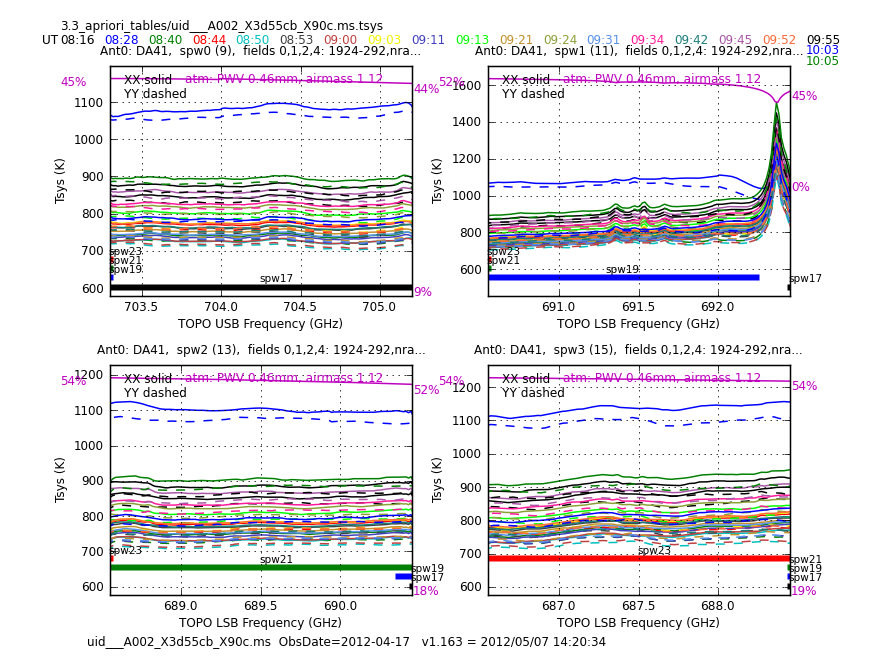
# Plot TDM Tsys tables, and show locations of FDM spws
os.system('rm -rf Tsysplots')
for vis in rawdata:
aU.plotbandpass('3.3_apriori_tables/'+vis+'.tsys',ms=vis,
overlay='time', xaxis='freq',
yaxis='amp',subplot=22,interactive=False,
showatm=True,
chanrange='5~122',showfdm=True,
figfile='Tsysplots/'+vis+'tsys.png')
Go through all the plots and make sure you notice all the next issues, since we will need to flag the corresponding science data.
X90c DV05 ripples all spw Otherwise 600 to 1200 47 to 57% transmission X575 Otherwise 1300 to 3000 28 to 39% transmission DV05 ripples all spw Xb50 800 to 2500 37 to 47% transmission DV05 ripples all spw X39b 500 to 800 56 to 65% DA43 Tsys crazy for spw=23 DV05 ripples all spw and one time with bad YY DV18 crazy for spw=23
Now, for the plotting of the wvr tables, we will employ again the analysis utils. This command will create a directory with all the plots inside, each one of them corresponding to different datasets, baselines and targets, using different colors. In Figure 2 you can see an example of the output for spectral window 1. Note that the command below only creates the plots for that spw, since the others are the same except for a scale factor that is the ratio of frequencies.
Note that in all datasets, DV15 has bad wvr behavior.
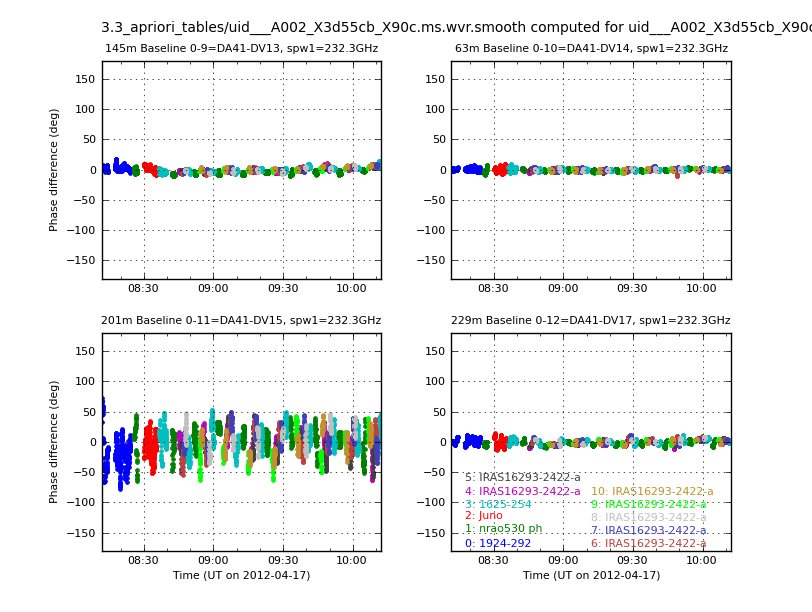
# Plotting wvr tables for spw 1
os.system('rm -rf WVRplots')
for vis in rawdata:
aU.plotWVRSolutions(caltable='3.3_apriori_tables/'+vis+'.wvr.smooth',
yrange=[-180,180],figfile='WVRplots/'+vis+'.wvr.smooth.png',
ms=vis,spw='1',interactive=False)
Before you continue it is important you save the flags status, so you can recover this state if you need to re-do the calibration.
# Saving the flags state as "Original".
rawdata=['uid___A002_X3d4118_X39b.ms','uid___A002_X3d55cb_X575.ms',
'uid___A002_X3d55cb_Xb50.ms','uid___A002_X3d55cb_X90c.ms']
for vis in rawdata:
flagmanager(vis=vis,mode='save',versionname='Original')
Now, based on the behavior of the tsys and wvr tables, we will flag the corresponding data, using the next commands. You can employ similar executions to flag other data you might want to remove.
# Flagging corresponding science data for tsys and wvr showing problems
for vis in rawdata:
flagdata(vis=vis,autocorr = T,flagbackup = F)
flagdata(vis=vis,mode='shadow',flagbackup=F)
flagdata(vis=vis,antenna='DV15',flagbackup=F)
vis='uid___A002_X3d4118_X39b.ms'
flagdata(vis=vis,antenna='DA43,DV18',spw='23',flagbackup=F)
# For now leave DV05 in but keep an eye on it.
Applying antpos, tsys, and wvr tables and splitting the data
As you could see from the initial application of listobs, 1924-292 is the bandpass calibrator for three of the datasets, and 3c279 is for one of them. For this reason, the application of the tables is split in two parts. Ignore the warnings from the first execution of applycal, since it does not harm the data.
# Re-entering our array
rawdata=['uid___A002_X3d4118_X39b.ms','uid___A002_X3d55cb_X575.ms',
'uid___A002_X3d55cb_Xb50.ms','uid___A002_X3d55cb_X90c.ms']
# Separate sources with Tsys measurements of their own from those that
# do not. Since only one IRAS16293 field (id=4) has Tsys, it goes into the
# "not" category.
field_Tsys=['1924-292','nrao530 ph','Juno']
field_noTsys=['1625-254','IRAS16293*']
for vis in rawdata:
for field in field_Tsys:
applycal(vis=vis,field=field,
spw = '17,19,21,23',
gaintable = ['3.3_apriori_tables/'+vis+'.tsys.fdm',
'3.3_apriori_tables/'+vis+'.wvr.smooth',
'3.3_apriori_tables/'+vis+'.antpos'],
gainfield = [field,field,''],
interp = ['linear','nearest',''],calwt = T,
flagbackup = F)
# This one dataset has 3C279 instead of 1924-292 as the bpcal and is the
# source of warnings in prevoius applycal
vis='uid___A002_X3d55cb_X575.ms'
field='3c279'
applycal(vis=vis,field=field,
spw = '17,19,21,23',
gaintable = ['3.3_apriori_tables/'+vis+'.tsys.fdm',
'3.3_apriori_tables/'+vis+'.wvr.smooth',
'3.3_apriori_tables/'+vis+'.antpos'],
gainfield = [field,field,''],
interp = ['linear','nearest',''],calwt = T,
flagbackup = F)
for vis in rawdata:
for field in field_noTsys:
applycal(vis =vis,field=field,
spw = '17,19,21,23',
gaintable = ['3.3_apriori_tables/'+vis+'.tsys.fdm',
'3.3_apriori_tables/'+vis+'.wvr.smooth',
'3.3_apriori_tables/'+vis+'.antpos'],
gainfield = ['4',field,''],
interp = ['linear','nearest',''],calwt = T,
flagbackup = F)
# Splitting the science spws
sciencespw='17,19,21,23'
for vis in rawdata:
split(vis=vis,outputvis=('%s.antwvrtsys.ms'%(vis.split('.')[0])),datacolumn='corrected',spw=sciencespw,keepflags=False)
Data inspection
We now need to check any bad behavior in the data through several plots. Once problems are identified, data can be flagged. But before that, we need to run again listobs to check that the split worked as expected. We will define our new array of split datasets, along with a list of intents that will be useful in the next steps.
# New array of datasets
data=['uid___A002_X3d4118_X39b.antwvrtsys.ms',
'uid___A002_X3d55cb_X575.antwvrtsys.ms',
'uid___A002_X3d55cb_X90c.antwvrtsys.ms',
'uid___A002_X3d55cb_Xb50.antwvrtsys.ms']
# Match up intents with source names
pcal='1625-254'
fluxcal='Juno'
science='IRAS16293*'
check='nrao530*'
bpcal=['1924-292','3c279','1924-292','1924-292']
calfields=['1924-292,Juno,1625-254,nrao530*',
'3c279,Juno,1625-254,nrao530*',
'1924-292,Juno,1625-254,nrao530*',
'1924-292,Juno,1625-254,nrao530*']
for vis in data:
listobs(vis=vis,listfile=vis+'.listobs',verbose=True)
You can explore any of the output files by doing cat file.listobs or using any other text reader from a terminal not running CASA. Next you can see the output for X90c, and you will see the change in the spw naming, among others.
Fields: 11 ID Code Name RA Decl Epoch SrcId nVis 0 none 1924-292 19:24:51.05600 -29.14.30.1280 J2000 0 13200 1 none nrao530 ph 17:33:02.72400 -13.04.49.4860 J2000 1 23760 2 none Juno 16:25:05.61170 -05.43.27.9210 J2000 2 10560 3 none 1625-254 16:25:46.98000 -25.27.38.3300 J2000 3 26400 4 none IRAS16293-2422-a 16:32:22.99200 -24.28.36.0000 J2000 4 11880 5 none IRAS16293-2422-a 16:32:22.47925 -24.28.36.0000 J2000 4 11880 6 none IRAS16293-2422-a 16:32:22.73563 -24.28.36.0000 J2000 4 11880 7 none IRAS16293-2422-a 16:32:22.73563 -24.28.32.5000 J2000 4 11880 8 none IRAS16293-2422-a 16:32:22.47925 -24.28.29.0000 J2000 4 10560 9 none IRAS16293-2422-a 16:32:22.73563 -24.28.29.0000 J2000 4 10560 10 none IRAS16293-2422-a 16:32:22.99200 -24.28.29.0000 J2000 4 10560 (nVis = Total number of time/baseline visibilities per field) Spectral Windows: (4 unique spectral windows and 1 unique polarization setups) SpwID #Chans Frame Ch1(MHz) ChanWid(kHz) TotBW(kHz) Corrs 0 3840 TOPO 703312.744 488.28125 1875000 XX YY 1 3840 TOPO 692237.256 488.28125 1875000 XX YY 2 3840 TOPO 690437.256 488.28125 1875000 XX YY 3 3840 TOPO 688437.256 488.28125 1875000 XX YY Sources: 20 ID Name SpwId RestFreq(MHz) SysVel(km/s) 0 1924-292 0 - - 0 1924-292 1 - - 0 1924-292 2 - - 0 1924-292 3 - - 1 Juno 0 - - 1 Juno 1 - - 1 Juno 2 - - 1 Juno 3 - - 2 1625-254 0 - - 2 1625-254 1 - - 2 1625-254 2 - - 2 1625-254 3 - - 3 nrao530 ph 0 - - 3 nrao530 ph 1 - - 3 nrao530 ph 2 - - 3 nrao530 ph 3 - - 4 IRAS16293-2422-a 0 - - 4 IRAS16293-2422-a 1 - - 4 IRAS16293-2422-a 2 - - 4 IRAS16293-2422-a 3 - - Antennas: 12: ID Name Station Diam. Long. Lat. 0 DA41 A003 12.0 m -067.45.16.5 -22.53.27.0 1 DA43 A075 12.0 m -067.45.17.9 -22.53.21.4 2 DV02 A077 12.0 m -067.45.10.1 -22.53.25.9 3 DV03 A137 12.0 m -067.45.15.2 -22.53.22.7 4 DV05 A082 12.0 m -067.45.08.3 -22.53.29.2 5 DV07 A076 12.0 m -067.45.20.5 -22.53.33.8 6 DV09 A046 12.0 m -067.45.17.0 -22.53.29.3 7 DV10 A071 12.0 m -067.45.19.9 -22.53.23.5 8 DV12 A011 12.0 m -067.45.14.4 -22.53.28.4 9 DV13 A072 12.0 m -067.45.12.6 -22.53.24.0 10 DV14 A025 12.0 m -067.45.18.7 -22.53.27.4 12 DV17 A138 12.0 m -067.45.17.1 -22.53.34.4
As we noted before, these observations contain datasets that were taken before and after transit of the science target. Elevation is especially important at Band 9 due to the increased airmass at low elevation and corresponding drop in transmission. By making plots for this we will note which datasets might be more affected by low elevation. In Figure 3 you can see the output of this command for Xb50.
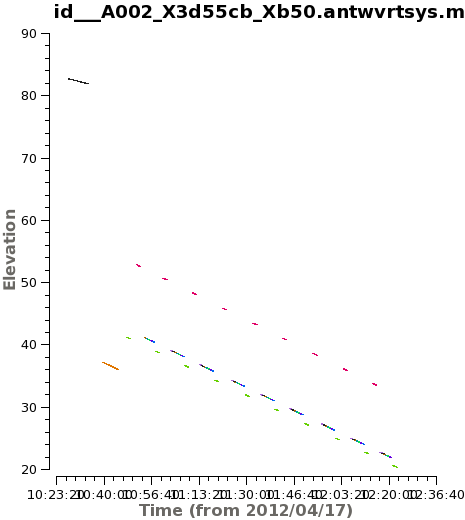
# Elevation plots to understand what the elevation range for each dataset is.
for vis in data:
plotms(vis=vis,
field='',xaxis='time', yaxis='elevation',antenna='',
spw='0', avgchannel='3840',coloraxis='field',
ydatacolumn='data',plotfile=vis+'elevation.png',title=vis)
Next, we give you a set of useful plotms commands which will help you to analyze all the data in several ways. You can save a copy of the output, so you do not have to run them again every time you want to check them. This is especially useful for the ones that take a lot of time to complete. In Figure 4 you can see the output of the following plotms command. By clicking the "Next" arrow in plotms you can access the remaining spws, since the command was executed with the option iteraxis='spw'.
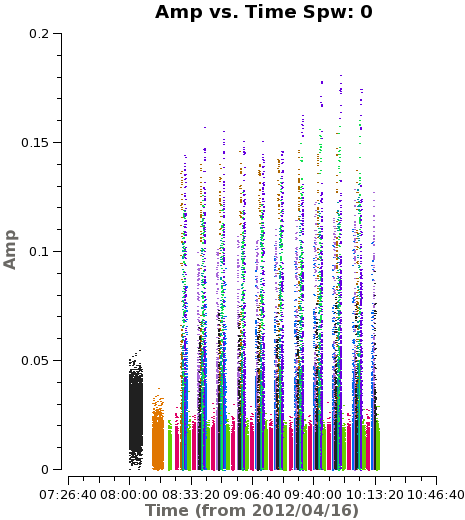
# Check overall behavior with time
vis=data[0]
plotms(vis=vis,
field='',xaxis='time', yaxis='amp',antenna='',
spw='', avgchannel='3840',coloraxis='field',
iteraxis='spw',ydatacolumn='data',yselfscale=True)
For the next plotms commands, inspect each dataset, noting any problems that you notice.
# For at least one spw go antenna by antenna to look for dropouts not
# obvious in previous plot
vis=data[0]
plotms(vis=vis,
field='',xaxis='time', yaxis='amp',antenna='',
spw='2', avgchannel='3840',coloraxis='field',
iteraxis='antenna',ydatacolumn='data')
# Check out spectral properties of each source for problems
vis=data[0]
plotms(vis=vis,
field='',xaxis='freq', yaxis='amp',antenna='',
spw='', avgtime='1e8',avgscan=True,coloraxis='spw',
iteraxis='field',ydatacolumn='data',yselfscale=True)
# Examine phase of the bandpass calibrator for any problems
vis=data[0]
bp=bpcal[0]
plotms(vis=vis,
field=bp,xaxis='freq', yaxis='phase',antenna='',
spw='', avgtime='1e8',avgscan=True,avgchannel='10',coloraxis='spw',
iteraxis='baseline',ydatacolumn='data',yselfscale=True)
Flagging
Next, based on our inspection we will proceed with the corresponding flagging. But before that, we will save the current flags state, so we can recover it later, if needed.
data=['uid___A002_X3d4118_X39b.antwvrtsys.ms',
'uid___A002_X3d55cb_X575.antwvrtsys.ms',
'uid___A002_X3d55cb_X90c.antwvrtsys.ms',
'uid___A002_X3d55cb_Xb50.antwvrtsys.ms']
# Back up flag state in case you want to start over.
for vis in data:
flagmanager(vis=vis,mode='save',versionname='Original')
# If you do start over run this first
for vis in data:
flagmanager(vis=vis,mode='restore',versionname='Original')
Here is the flag that we will do. If you note some other data that needs to be flagged, proceed with that.
# DV07 low amp after certain time. DV17 also but not as bad.
flagdata(vis='uid___A002_X3d55cb_X575.antwvrtsys.ms',
antenna='DV07', timerange='>05:20:00',flagbackup=F)
Now, during the procedure of calibration some problems in the data will show up. Those data needed to be flagged and do the calibration again. In order to save you time with this, we note here those problems, so you can flag the data now.
# AFTER INITIAL CALIBRATION INSPECTION
# flag low elevation scans on 1625-254 and IRAS16293
flagdata(vis='uid___A002_X3d55cb_Xb50.antwvrtsys.ms',
timerange='>12:03:00', field='',flagbackup=F)
# flag low gains on DV02 on Juno
flagdata(vis='uid___A002_X3d55cb_Xb50.antwvrtsys.ms',
antenna='DV02', field='Juno',flagbackup=F)
flagdata(vis='uid___A002_X3d4118_X39b.antwvrtsys.ms',
antenna='DV02', field='Juno',flagbackup=F)
Calibration
Now we can start with the calibration itself. First, we will perform the bandpass calibration using 1924-292 and 3c279. As before, we define our list of data and match the sources with intents. Also, we will set our reference antenna (one close to the center of the array and without problems, like delays). As you can see, two different intervals for channels are used, which make sense in a bit.
data=['uid___A002_X3d4118_X39b.antwvrtsys.ms',
'uid___A002_X3d55cb_X575.antwvrtsys.ms',
'uid___A002_X3d55cb_X90c.antwvrtsys.ms',
'uid___A002_X3d55cb_Xb50.antwvrtsys.ms']
# Match up intents with source names
pcal='1625-254'
fluxcal='Juno'
science='IRAS16293*'
check='nrao530*'
bpcal=['1924-292','3c279','1924-292','1924-292']
calfields=['1924-292,Juno,1625-254,nrao530*',
'3c279,Juno,1625-254,nrao530*',
'1924-292,Juno,1625-254,nrao530*',
'1924-292,Juno,1625-254,nrao530*']
# Setup calibration parameters
prebpchan='0~3:1200~1500'
calchan='0~3:20~3820'
refant='DV14'
gaps=5
os.system('rm -rf *cal')
Note that if at some point during the calibration process you need to start over, then you will need to clear all the columns for solutions in the data, as shown next.
# The clearcal below is essential if you are starting over
for vis in range(len(data)):
clearcal(vis=data[vis])
setjy(vis=data[vis],field=fluxcal,standard='Butler-JPL-Horizons 2010',
scalebychan=True)
Now we proceed with the bandpass, which will be done in two steps. In the first one, we will use the block of channels in the center of the spws, 1200~1500, to calculate gains in phase, using a solution interval of 30 seconds. This will give us the variation of the phase through all the observation. We will use this table later to execute the bandpass itself. Note that we are using a minimum of signal to noise ratio of 2 to accept the solutions. This is low but needed since the calibrators are not very strong in band 9.
# Calculating phase variation with time
for vis in range(len(data)):
gaincal(vis=data[vis],caltable=data[vis]+'.bpphase.gcal',
field=bpcal[vis],spw=prebpchan,refant=refant,
calmode='p',solint='30s',minsnr=2.0,minblperant=4)
Next, we set our bandpass command to use our previously generated gain tables. Since we do not have a high signal to noise ratio per channel, we use a polynomial option to calculate the solutions for the bandpass. In the bandpass task, the options degamp and degphase will set the maximum degree of the polynomial that the task can use to calculate solutions. In the work log you can note what is the actual degree that the task is using. Note that the combination of solint='inf' and combine='scan' will result in a solution per scan for the calibrator.
# Bandpass calibration using previous tables as input
for vis in range(len(data)):
bandpass(vis=data[vis],caltable=data[vis]+'.bandpass.bcal',
field=bpcal[vis],spw='',combine='scan',refant=refant,
solint='inf',solnorm=T,minblperant=4,fillgaps=gaps,
gaintable=[data[vis]+'.bpphase.gcal'])
for vis in range(len(data)):
bandpass(vis=data[vis],caltable=data[vis]+'.bandpass_bpoly.bcal',
field=bpcal[vis],spw='',combine='scan',refant=refant,
solint='inf',solnorm=T,minblperant=4,fillgaps=gaps,
bandtype='BPOLY',degamp=7,degphase=7,
gaintable=[data[vis]+'.bpphase.gcal'])
To plot all our tables we will use both our AnalysisUtils and plotcal. The aU.plotbandpass command will create plot files for each combination of dataset and antenna, for both amplitude and phase. Inspect all these plots to make sure that the bandpass solutions look good. In Figure 5 we show an output sample for this command.
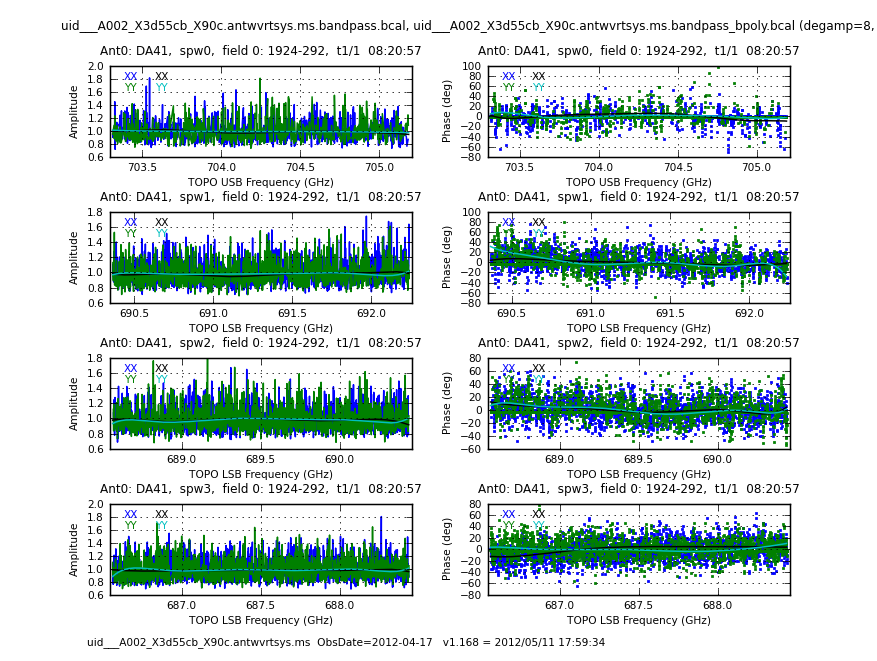
# Set some plotting things
SPW=['0','1','2','3']
numants=16 # max for any of the input datasets
os.system('rm -rf cal_plots')
os.system('mkdir cal_plots')
os.system('rm -rf cal_plots/*bandpass_bpoly.bcal.*png')
for vis in range(len(data)):
aU.plotbandpass(caltable=data[vis]+'.bandpass.bcal',
caltable2=data[vis]+'.bandpass_bpoly.bcal',
field=bpcal[vis],xaxis='freq',yaxis='both',
figfile='cal_plots/'+data[vis]+'.bandpass_bpoly.png',
interactive=False,subplot=42)
The next step in the calibration is to calculate amplitude and phase gains vs time for our calibrators. The ideal case here is to have a solution per integration of the data, but in this case we will need to use a solution interval of 30 seconds to avoid having many failed solutions, especially in the week phase calibrator. First, we will calculate gains for phase and later using that information, we will solve for amplitude and phase. In all the next three executions we are using the bandpass calibration table, as it provides the gains for phase and amplitude vs frequency.
#Using 30s (5 integrations) per solution to avoid many failed solution of the week calibrator.
for vis in range(len(data)):
gaincal(vis=data[vis],caltable=data[vis]+'.intphase.gcal',
field=calfields[vis],spw=calchan,refant=refant,
calmode='p',solint='30s',minsnr=2.0,minblperant=4,
gaintable=[data[vis]+'.bandpass_bpoly.bcal'])
To plot our *.intphase.gcal tables we use the next command, which will create files containing the phase gains vs time for all the atennas and for all the datasets. In Figure 6 we show an example of such plots. Again, you will need to check all plots to make sure the solutions are good.
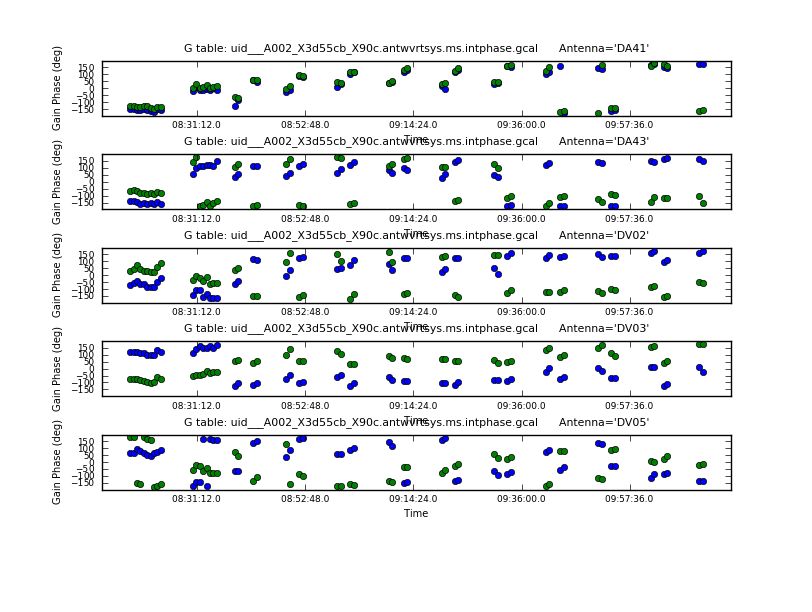
# Plotting phase gains vs time
os.system('rm -rf cal_plots/*intphase*png')
for vis in data:
for spw in SPW:
for antenna in range(0,numants,5):
plotcal(caltable=vis+'.intphase.gcal',
xaxis='time',yaxis='phase',antenna='%d~%d'%(antenna,antenna+4),
iteration='antenna',subplot=511,poln='',spw=spw,
showgui=F,
figfile='cal_plots/'+vis+'.intphase.gcal.spw%s.ant%d_%d.png'%(spw,antenna,antenna+4),
fontsize=8.0,plotrange=[0,0,-180,180])
Next we will use gaincal to solve for gain phases for all the calibrators, but this time we will get one single solution per scan.
# Gaincal execution as before, but to get a single solution per scan
for vis in range(len(data)):
gaincal(vis=data[vis],caltable=data[vis]+'.scanphase.gcal',
field=calfields[vis],spw=calchan,refant=refant,
calmode='p',solint='inf',minsnr=2.0,minblperant=4,
gaintable=[data[vis]+'.bandpass_bpoly.bcal'])
The next command will produce many plots, and like the previous one, you will get one for each dataset and for each antenna. See example in Figure 7.
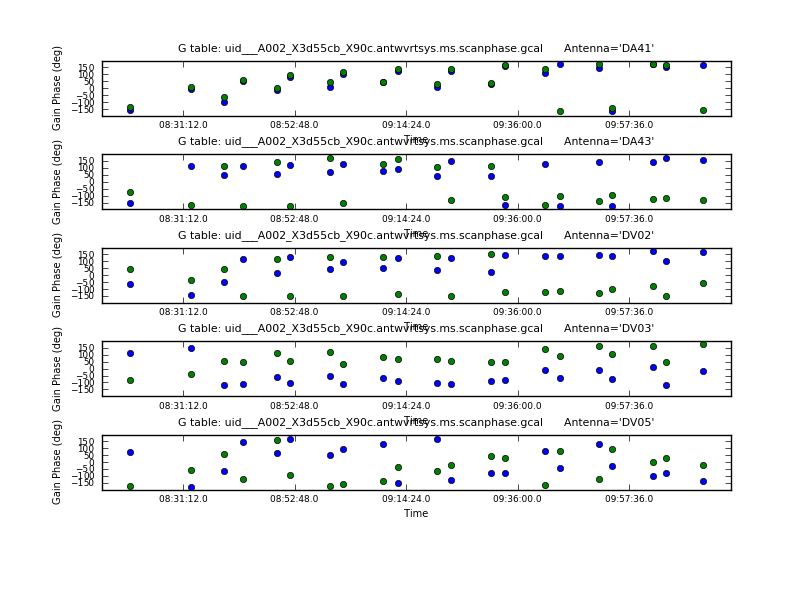
# Phase vs time plotting for our calibrators
os.system('rm -rf cal_plots/*scanphase*png')
for vis in data:
for spw in SPW:
for antenna in range(0,numants,5):
plotcal(caltable=vis+'.scanphase.gcal',
xaxis='time',yaxis='phase',antenna='%d~%d'%(antenna,antenna+4),
iteration='antenna',subplot=511,poln='',spw=spw,
showgui=F,
figfile='cal_plots/'+vis+'.scanphase.gcal.spw%s.ant%d_%d.png'%(spw,antenna,antenna+4),
fontsize=8.0,plotrange=[0,0,-180,180])
Finally, in the next gaincal we will solve for amplitude and phase. We ill use the gain phase calibration table produced before. We will get one solution per scan for all our calibrators.
# Gaincal solving for amplitude and phase vs time.
for vis in range(len(data)):
gaincal(vis=data[vis],caltable=data[vis]+'.amp.gcal',
field=calfields[vis],spw=calchan,refant=refant,
calmode='ap',solint='inf',minsnr=2.0,minblperant=4,
gaintable=[data[vis]+'.bandpass_bpoly.bcal',data[vis]+'.intphase.gcal'])
We now can check the resulting plots with the next plotcal executions. In Figure 8 we show an example of these plots.
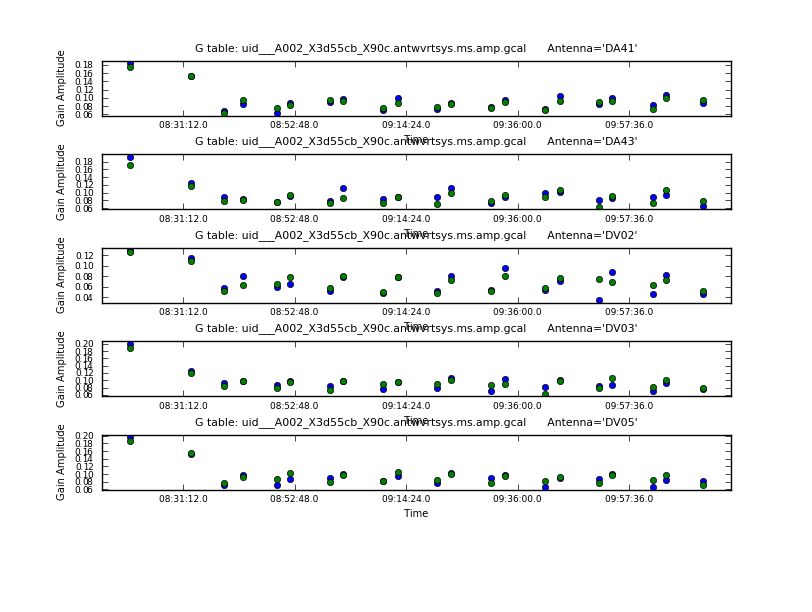
# Plotting gain amplitudes as function of time.
os.system('rm -rf cal_plots/*amp*png')
for vis in data:
for spw in SPW:
for antenna in range(0,numants,5):
plotcal(caltable=vis+'.amp.gcal',
xaxis='time',yaxis='amp',antenna='%d~%d'%(antenna,antenna+4),
iteration='antenna',subplot=511,poln='',spw=spw,
figfile='cal_plots/'+vis+'.amp.gcal.spw%s.ant%d_%d.png'%(spw,antenna,antenna+4),
fontsize=8.0)
We can plot the same tables but in a different way that will allow us to look for higher abnormal gains in the solutions. With the next command we will get only four plots for each spw. Each of those plots shows all the gains for all the antennas for all the sources (See Figure 9 for an example). Below in the box, there are some comments to focus you on some data, so you can double check. Before continuing, make sure you check all the calibration tables.
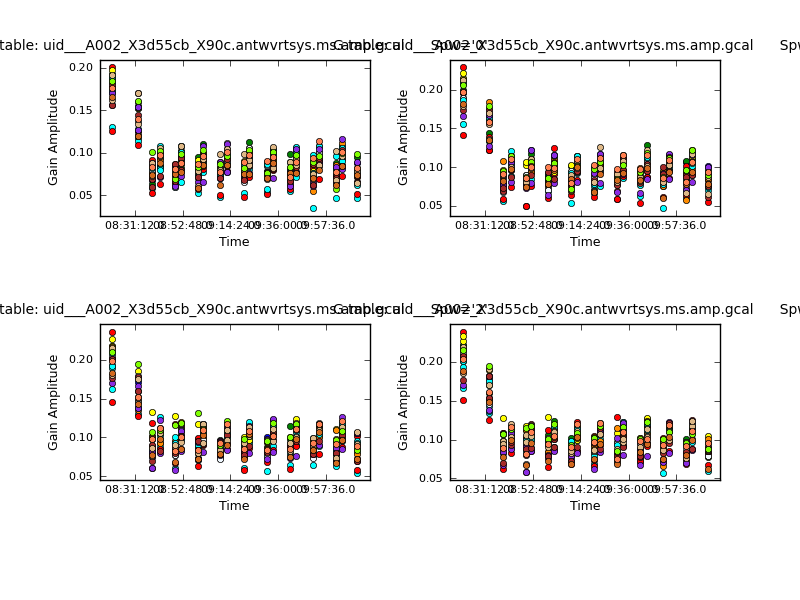
# Look for low or high gains compared to other data
os.system('rm -rf *amp.png')
for vis in data:
plotcal(caltable=vis+'.amp.gcal',
xaxis='time',yaxis='amp',antenna='',field='',
iteration='spw',subplot=221,poln='',spw='',
showgui=False,figfile=vis+'.amp.png')
# X90c good
# X575 one antenna spw=0
# Xb50 end times bad all spws (low el), spw=0 more; low DV02 on Juno
# X39b low DV02 on Juno
Now that the gain calibration is done, we need to set the flux for our calibrators. For this we will use Juno, our primary flux calibrator. We will do this by using fluxscale. We then will transfer the flux information from our phase calibrator to our science target. For these datasets, we note the following for this step: The derived flux densities for X39b, X90c, and Xb50 are quite reasonable. The results for X575 are a little high, probably because Juno was at low elevation for these observations.
# Setting fluxes for the calibrators
for vis in range(len(data)):
fluxscale(vis=data[vis],caltable=data[vis]+'.amp.gcal',
fluxtable=data[vis]+'.flux.cal',reference=fluxcal)
Analyze all the numbers coming out in the log window and write them now, as they can serve you as a reference later on.
When derived fluxes are too high and nothing else appears wrong with the data, the cause especially at Band 9 is likely decorrelation. So we will favor the average of the lower values to explicitly set the flux densities based on the fluxscale results. We set the two bandpass calibrators for convenience of having fully calibrated dataset. The only ones that really matter are 1625 as the gain calibrator and the check source nrao530. Based on this, we proceed as following to make the changes that are needed:
# Fixing the fluxes
flux1924=[1.7,0,0,0]
flux1625=[0.31,0,0,0]
fluxnrao530=[0.47,0,0,0]
flux3c279=[7.4,0,0,0]
datawith1924=['uid___A002_X3d4118_X39b.antwvrtsys.ms',
'uid___A002_X3d55cb_X90c.antwvrtsys.ms',
'uid___A002_X3d55cb_Xb50.antwvrtsys.ms']
for vis in datawith1924:
setjy(vis=vis,field='1924-292',fluxdensity=flux1924)
setjy(vis=vis,field='1625-254',fluxdensity=flux1625)
setjy(vis=vis,field='nrao530*',fluxdensity=fluxnrao530)
setjy(vis='uid___A002_X3d55cb_X575.antwvrtsys.ms',field='3c279',
fluxdensity=flux3c279)
We now need to re-run the amplitude calibration step.
#This new amplitude calibration will be used in the applycal.
data=['uid___A002_X3d4118_X39b.antwvrtsys.ms',
'uid___A002_X3d55cb_X575.antwvrtsys.ms',
'uid___A002_X3d55cb_X90c.antwvrtsys.ms',
'uid___A002_X3d55cb_Xb50.antwvrtsys.ms']
# Match up intents with source names
pcal='1625-254'
fluxcal='Juno'
science='IRAS16293*'
check='nrao530*'
bpcal=['1924-292','3c279','1924-292','1924-292']
calfields=['1924-292,Juno,1625-254,nrao530*',
'3c279,Juno,1625-254,nrao530*',
'1924-292,Juno,1625-254,nrao530*',
'1924-292,Juno,1625-254,nrao530*']
for vis in range(len(data)):
gaincal(vis=data[vis],caltable=data[vis]+'.amp.final.gcal',
field=calfields[vis],spw=calchan,refant=refant,
calmode='ap',solint='inf',minsnr=2.0,minblperant=4,
gaintable=[data[vis]+'.bandpass_bpoly.bcal',data[vis]+'.intphase.gcal'])
Application of calibration tables
Now that we have all the calibration tables and that we are happy with the results, both in gains and fluxes, we need to apply all the tables to the data.
data=['uid___A002_X3d4118_X39b.antwvrtsys.ms',
'uid___A002_X3d55cb_X575.antwvrtsys.ms',
'uid___A002_X3d55cb_X90c.antwvrtsys.ms',
'uid___A002_X3d55cb_Xb50.antwvrtsys.ms']
# Match up intents with source names
pcal='1625-254'
fluxcal='Juno'
science='IRAS16293*'
check='nrao530*'
bpcal=['1924-292','3c279','1924-292','1924-292']
for vis in range(len(data)):
flagmanager(vis=data[vis],mode='save',versionname='beforeapplycal')
for vis in range(len(data)):
applycal(vis=data[vis],field=bpcal[vis],
gaintable=[data[vis]+'.bandpass_bpoly.bcal',data[vis]+'.intphase.gcal',
data[vis]+'.amp.final.gcal'],
interp=['nearest','nearest','nearest'],
gainfield=[bpcal[vis],bpcal[vis],bpcal[vis]],flagbackup=F,calwt=F)
for vis in range(len(data)):
applycal(vis=data[vis],field=pcal,
gaintable=[data[vis]+'.bandpass_bpoly.bcal',data[vis]+'.intphase.gcal',
data[vis]+'.amp.final.gcal'],
interp=['nearest','nearest','nearest'],
gainfield=[bpcal[vis],pcal,pcal],flagbackup=F,calwt=F)
for vis in range(len(data)):
applycal(vis=data[vis],field=fluxcal,
gaintable=[data[vis]+'.bandpass_bpoly.bcal',data[vis]+'.intphase.gcal',
data[vis]+'.amp.final.gcal'],
interp=['nearest','nearest','nearest'],
gainfield=[bpcal[vis],fluxcal,fluxcal],flagbackup=F,calwt=F)
for vis in range(len(data)):
applycal(vis=data[vis],field=science,
interp=['nearest','linear','linear'],
gaintable=[data[vis]+'.bandpass_bpoly.bcal',data[vis]+'.scanphase.gcal',
data[vis]+'.amp.final.gcal'],
gainfield=[bpcal[vis],pcal,pcal],flagbackup=F,calwt=F)
for vis in range(len(data)):
applycal(vis=data[vis],field=check,
interp=['nearest','linear','linear'],
gaintable=[data[vis]+'.bandpass_bpoly.bcal',data[vis]+'.scanphase.gcal',
data[vis]+'.amp.final.gcal'],
gainfield=[bpcal[vis],pcal,pcal],flagbackup=F,calwt=F)
Plot corrected data
The next commands will help you visualize the result of the application of the calibration tables to the data. You can check if the amplitudes and phases vs time and frequency look reasonable for all the sources, in particular for the science target fields.
The next command will produce four plots, as the one we showed in Figure 4, but the amplitude in this new plots corresponds to flux because we now have calibrated data. See Figure 10 for an example of it. It is important to check that all the sources have similar amplitude (flux) in the different spws and datasets.
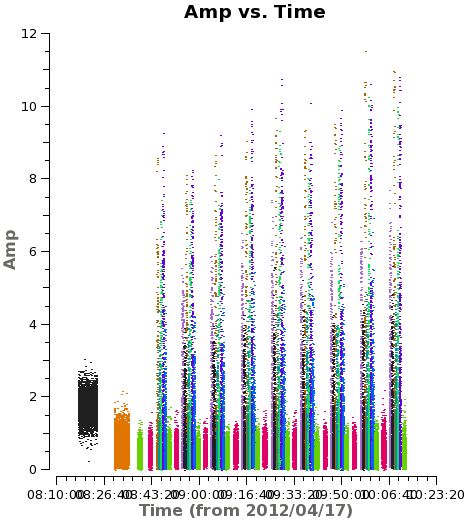
data=['uid___A002_X3d4118_X39b.antwvrtsys.ms',
'uid___A002_X3d55cb_X575.antwvrtsys.ms',
'uid___A002_X3d55cb_X90c.antwvrtsys.ms',
'uid___A002_X3d55cb_Xb50.antwvrtsys.ms']
# Match up intents with source names
pcal='1625-254'
fluxcal='Juno'
science='IRAS16293*'
check='nrao530*'
bpcal=['1924-292','3c279','1924-292','1924-292']
calfields=['1924-292,Juno,1625-254,nrao530*',
'3c279,Juno,1625-254,nrao530*',
'1924-292,Juno,1625-254,nrao530*',
'1924-292,Juno,1625-254,nrao530*']
# Set some plotting things
SPW=['0','1','2','3']
os.system('rm -rf aftercal_plots')
os.system('mkdir aftercal_plots')
os.system('rm -rf aftercal_plots/*cal.time*.png')
for vis in range(len(data)):
for spw in SPW:
plotms(vis=data[vis],spw=spw,xaxis='time',yaxis='amp',field='',avgchannel='3840',
coloraxis='field',ydatacolumn='corrected',
plotfile='aftercal_plots/'+data[vis]+'.cal.time.spw%s.png'%(spw))
It is also important to check the phases vs time for all the sources. The next command will get you the corresponding plots, four for each dataset. You can see that while the bandpass and amplitude calibrator have very concentrated phases around 0 degrees, the phase calibrator and the science target do not. In Figure 11 we show an example of these plots for spw 3 in the dataset X90c.
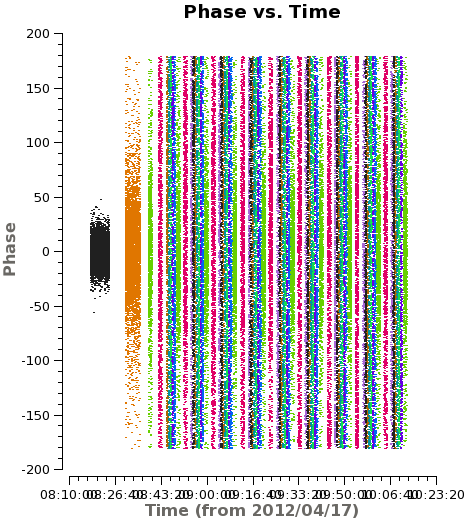
os.system('rm -rf aftercal_plots/*cal.time.phase*.png')
for vis in range(len(data)):
for spw in SPW:
plotms(vis=data[vis],spw=spw,xaxis='time',yaxis='phase',field='',avgchannel='3840',
coloraxis='field',ydatacolumn='corrected',
plotfile='aftercal_plots/'+data[vis]+'.cal.time.phase.spw%s.png'%(spw))
We now check the amplitude of the sources vs frequency. This is important since we expect that all the spw have very similar behavior. You will have one plot for each field for each dataset. In Figure 12 we show the case for 1625-254, our phase calibrator, for X90c.
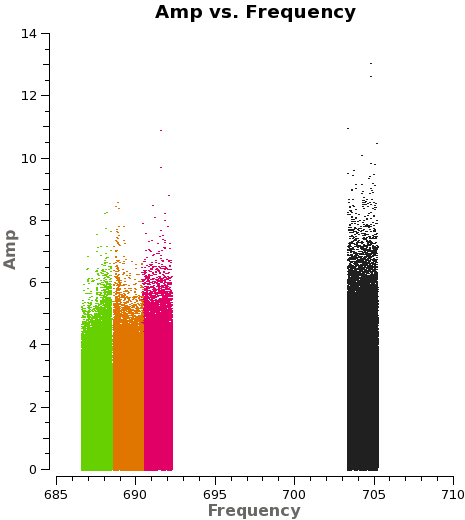
os.system('rm -rf aftercal_plots/*cal.freq.amp*.png')
for vis in range(len(data)):
for field in calfields[vis].split(','):
plotms(vis=data[vis],field='%s'%field,xaxis='freq', yaxis='amp',
spw='',avgtime='1e8',avgscan=T,
coloraxis='spw',xselfscale=T,ydatacolumn='corrected',
plotfile='aftercal_plots/'+data[vis]+'.cal.freq.amp.'+field+'.png')
The next command will produce similar plots but this time of phase vs frequency (see Figure 13 for an example). You will notice that only strong sources, like 3c279, will show clearly phases concentrated around 0 degrees.
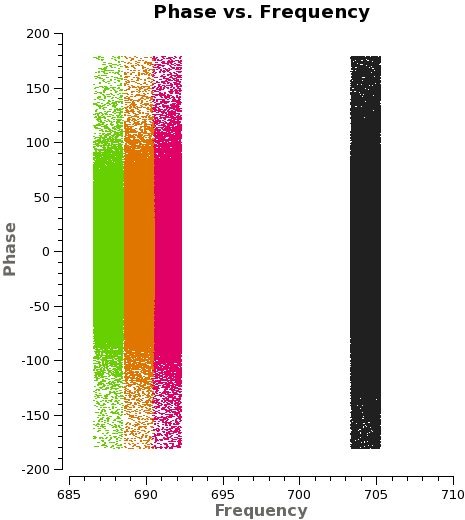
os.system('rm -rf aftercal_plots/*cal.freq.phase*.png')
for vis in range(len(data)):
for field in calfields[vis].split(','):
plotms(vis=data[vis],field='%s'%field,xaxis='freq', yaxis='phase',
spw='',avgtime='1e8',avgscan=T,
coloraxis='spw',xselfscale=T,ydatacolumn='corrected',
plotfile='aftercal_plots/'+data[vis]+'.cal.freq.phase.'+field+'.png')
Finally, for our science target, we plot amplitude (flux) vs frequency for all the spectral windows. See an example of this is Figure 14 and 15.
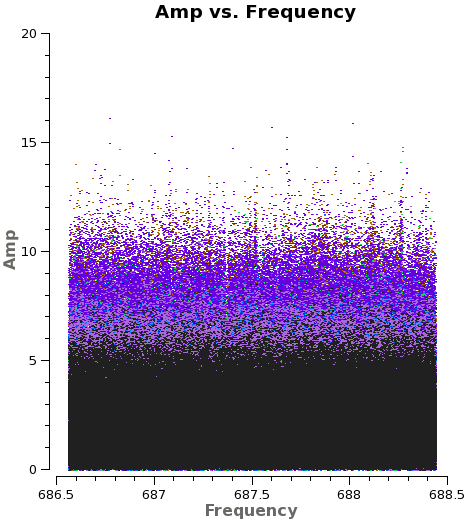
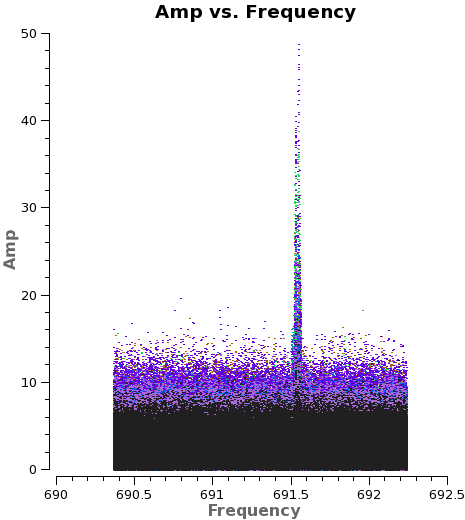
os.system('rm -rf aftercal_plots/*science.freq.amp*.png')
for vis in range(len(data)):
plotms(vis=data[vis],field=science,xaxis='freq', yaxis='amp',
spw=spw,avgtime='1e8',avgscan=T,
coloraxis='field',xselfscale=T,ydatacolumn='corrected',
plotfile='aftercal_plots/'+data[vis]+'.science.freq.amp.png')
Next, we put a list of additional plotms commands that do not produce .png files, but that you can explore and save a copy of the output file if you are interested.
# Additional manual plots
vis=data[0]
plotms(vis=vis,spw='',xaxis='time',yaxis='amp',field='',avgchannel='3840',
coloraxis='field',ydatacolumn='corrected',iteraxis='spw')
vis=data[1]
plotms(vis=vis,field=bpcal[1],xaxis='freq', yaxis='amp',
spw='2',avgtime='1e8',avgscan=T,iteraxis='antenna',
coloraxis='field',xselfscale=T,ydatacolumn='corrected')
vis=data[1]
plotms(vis=vis,field=calfields[1],xaxis='freq', yaxis='amp',
spw='',avgtime='1e8',avgscan=T,
coloraxis='field',xselfscale=T,ydatacolumn='corrected')
Split and concatenate the calibrated data
You are ready now to extract the final calibrated data for the science target. Of course, you can do something similar for the calibrators if you are interested.
# Splitting final calibrated datasets
data=['uid___A002_X3d4118_X39b.antwvrtsys.ms',
'uid___A002_X3d55cb_X575.antwvrtsys.ms',
'uid___A002_X3d55cb_X90c.antwvrtsys.ms',
'uid___A002_X3d55cb_Xb50.antwvrtsys.ms']
for vis in data:
split(vis=vis,outputvis='%s.cal.IRAS16293.ms'%(vis.split('.')[0]),
datacolumn='corrected',field='IRAS16293*',keepflags=False)
There are now four datasets fully calibrated. We finally will merge these datasets into a single one, in order to proceed with the analysis and imaging in both continuum and spectral line.
# Concatenating the final split files
data=['uid___A002_X3d4118_X39b.cal.IRAS16293.ms',
'uid___A002_X3d55cb_X575.cal.IRAS16293.ms',
'uid___A002_X3d55cb_X90c.cal.IRAS16293.ms',
'uid___A002_X3d55cb_Xb50.cal.IRAS16293.ms']
concat(vis=data,concatvis='IRAS16293_Band9.ms')
Now you have everything you need to the imaging part. Follow IRAS16293 Band9 - Imaging to go to the imaging section of this casaguide.